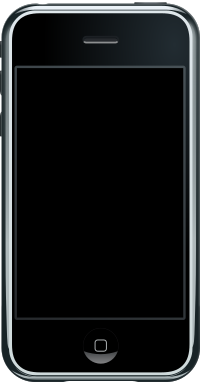 | |
 Front view | |
| Developer | Apple |
|---|---|
| Manufacturer | Foxconn (contract manufacturer) [1] |
| Type | Smartphone |
| Series | iPhone |
| First released | June 29, 2007 |
| Discontinued | July 15, 2008 |
| Units sold | 6,124,000 |
| Predecessor | iPod Motorola Rokr E1 |
| Successor | iPhone 3G |
| Related | iPad, iPod Touch (comparison) |
| Form factor | Slate |
| Dimensions | 115 × 61 × 11.6 mm (4.53 × 2.40 × 0.46 in) |
| Weight | 135 g (4.8 oz) |
| Operating system |
|
| Memory | 128 MB eDRAM [2] |
| Storage | 4, 8, or 16 GB flash memory |
| SIM | Mini SIM |
| Battery | 3.7 V 1400 mAh Lithium-ion battery [3] |
| Charging | 30-pin Apple proprietary charging. |
| Rear camera | 2.0 MP with geotagging (not GPS-based) |
| Front camera | None |
| Display |
|
| Sound |
|
| Connectivity |
|
| Data inputs | |
| Website | Apple – iPhone at the Wayback Machine (archived June 29, 2007) |
| This article is part of a series on the |
| iPhone |
|---|
The iPhone [a] (also known as the iPhone 1st generation or iPhone 2G) is a smartphone developed and marketed by Apple as the first device in the iPhone lineup of smartphones. It features a Samsung S5L8900 SoC (90 nm), a 3.5 in multi-touch display, and a web browser (Safari). After years of rumors and speculation, it was officially announced on January 9, 2007, [7] and was released in the United States on June 29, 2007.
Contents
- Development history
- Release and performance
- Initial release
- Post-release
- Sales
- Reception and legacy
- Critical reception
- Legacy
- Hardware
- External hardware (screens, materials, etc)
- Internal hardware (motherboard, system-on-chip, etc.)
- Software
- Software history
- See also
- Notes
- References
- External links
Development of the iPhone began in 2005 and continued in secrecy until its public unveiling at Macworld 2007. The device broke with prevailing mobile phone designs by eliminating most physical hardware buttons, and relying on a finger-friendly touchscreen interface that did not need a stylus. The iPhone featured quad-band GSM cellular connectivity with GPRS and EDGE support for data transfer, and it used continuous internet access and onboard processing to support features unrelated to voice communication.
The iPhone generated much hype before release, [8] and it quickly became Apple's most successful product, although it was met with less enthusiasm in European territories. [9] At the time, the iPhone appealed largely to the general public, as opposed to the business community, upon which BlackBerry and IBM were primarily focused. By integrating existing technology and expanding on usability, the iPhone turned the smartphone industry "on its head", [10] and later generations of the iPhone propelled Apple to become one of the world's most profitable companies. [11] Its successor, the iPhone 3G, was announced on June 9, 2008.

